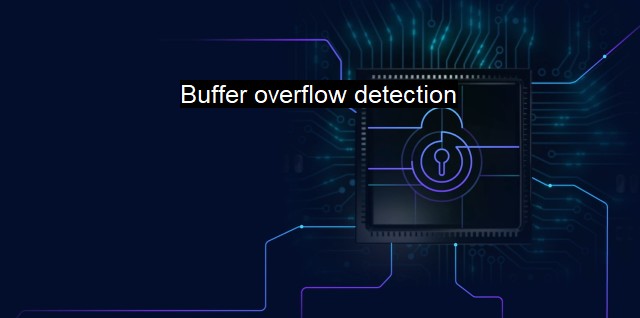What is Buffer overflow detection?
Detecting and Eliminating Buffer Overflow Vulnerabilities in Cybersecurity: A Comprehensive Analysis of Modern Antivirus Software
Buffer overflow detection forms a crucial line of defense in today's cybersecurity framework. Primarily, it deals with detecting and preventing instances of buffer overflow, a common type of cyber attack. In computer programming, a buffer is a temporary space in memory for storing data waiting to be processed. there's a limitation to the size of data that a buffer can hold. When a program tries to store more data in a buffer than it can accommodate, a buffer overflow occurs.In a context as delicate as personal or organizational cybersecurity, a buffer overflow can have serious implications. The buffeted excess data spills over into adjacent buffers, and this overwriting process can corrupt or overwrite the data they were originally holding. Buffer overflows may occur unintentionally through programming errors, but more commonly these represent deliberately targeted attacks within the field of cybercrime. By sending excessive data to an application, fraudsters can overflow the buffer and manipulate the system to execute arbitrary code that exploits the system, frequently leading to unauthorized system access or data leakage.
Buffer overflow attacks range in sophistication, depending on the type of buffer overflow security vulnerability targeted. In a stack-based buffer overflow attack, attackers exploit applications or processes that use a stack, also known as procedural memory—a common type of buffer that holds temporary variables created by each function. Another type, the heap-based buffer overflow attack, targets the heap -- a portion of a computer’s memory space used for dynamic memory allocation.
With such risks at hand, buffer overflow detection has become an integral part of cybersecurity mechanisms and antivirus solutions. It mainly involves an array of techniques to identify and tackle potential buffer overflow attacks, focusing on nipping the problem in the bud before it wreaks havoc on the system.
An effective buffer overflow detection system inspects patterns in applications to detect anomalies synonymous with buffer overflow attacks. It observes code integrity, monitors pointers and addresses, keeps a close eye on the application or code inputs, and has a command over stack management. the technology behind buffer overflow detection is the same in most places. Static code analysis of applications is performed, allowing the identifications of vulnerabilities. Thereafter, threats can either be resolved or patched appropriately to uphold system integrity.
Modern antivirus solutions often incorporate some form of buffer overflow detection to improve their effectiveness. These use heuristic scanning methods, signature-based detection, behavior blocking, or vulnerability shields to monitor system processes and detect anomalies suggesting a buffer overflow attack is underway.
Most newer programs and operating systems use techniques like address space layout randomization (ASLR), which places different areas of a program’s data areas in randomized locations within the address space, reducing the likelihood of prediction by an attacker. Another technique adopted is Data Execution Prevention (DEP), which marks areas of memory as either executable or non-executable, preventing an attacker from executing arbitrary code on affected sections.
Buffer overflow detection is a computer security technique used primarily for identifying potential sites of buffer overflow attacks. Through a mix of preventive and responsive measures, such as static code analysis, pattern checking, address randomization, and execution prevention, it helps prevent cyber attacks, plays a crucial role in safeguarding digital assets, and builds more resilient digital infrastructure within organizations. The study and enhancements in buffer overflow detection mark a significant stride towards a safer and secure cyber economy, serving individuals and enterprises alike.

Buffer overflow detection FAQs
What is buffer overflow detection?
Buffer overflow detection is a security mechanism that identifies and prevents cyberattacks that use buffer overflow exploits.How does buffer overflow detection work?
Buffer overflow detection works by monitoring the execution of a program and detecting when a buffer overflow exploit attempts to access or overwrite memory outside the bounds of a buffer. This is done through various techniques, such as canary values, bounds checking, and stack cookies.Why is buffer overflow detection important for antivirus software?
Buffer overflow exploits are a common tactic used by malware to gain unauthorized access to a system or execute malicious code. By incorporating buffer overflow detection into antivirus software, it can better protect against these types of attacks and prevent the spread of malware.What are the limitations of buffer overflow detection?
While buffer overflow detection is an effective security mechanism, it is not foolproof. Attackers can use advanced techniques to bypass detection and exploit vulnerabilities in a system. Additionally, some buffer overflow exploits may be more difficult to detect than others, making it important for software developers to incorporate multiple layers of security measures to protect against cyberattacks.| | A | | | B | | | C | | | D | | | E | | | F | | | G | | | H | | | I | | | J | | | K | | | L | | | M | |
| | N | | | O | | | P | | | Q | | | R | | | S | | | T | | | U | | | V | | | W | | | X | | | Y | | | Z | |
| | 1 | | | 2 | | | 3 | | | 4 | | | 7 | | | 8 | | |||||||